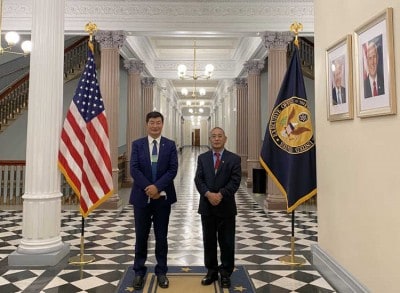By Atul Aneja
New Delhi, Jan 25 : Chinas intrusion into Ladakh is rooted in Beijings Middle Kingdom mentality and the five-finger strategy of Mao Zedong for the region, says Lobsang Sangay, President of the Central Tibetan Authority (CTA).
In an exclusive interview with India Narrative, Sangay said that India should not have been surprised either by the 2017 Doklam incident or the recent Ladakh intrusion as both events were rooted in the six decades old five finger strategy of Mao, the founder the People’s Republic of China (PRC).
“I have said it on (Indian) national television many times that China has a five-finger policy. Tibet is the palm (so they decided) to occupy Tibet. Then (they thought) let us capture Ladakh… Let’s (also) capture Nepal, Bhutan, Sikkim and Arunachal, and in between there is Uttarakhand and Himachal also. So, this was in the 1950s. So, when Galwan happened or when Doklam happened there was surprise as to how this happened. But 60 years ago (China had) openly declared (its view).”
He added: What is happening in Nepal? It is nothing new, it has been said before. The reality is that not only are they (the Chinese) interfering in Nepal and Burma, but also in Indian territory.
The Darjeeling-born and Harvard educated Sikyong, or President, of the CTA—the Tibetan government in exile—stressed that “expansionism” is part of the Chinese DNA and it is rooted in Beijing’s deeply embedded Middle Kingdom mentality. “The term Zhongguo (the commonly known name of China) means Middle Kingdom. All in the periphery are barbarians. Tibetans are Barbarians, Indians are barbarians, everybody; they are the greatest civilization, the greatest race and all have to be civilized. So, expansionism is in their DNA. If you really think that they will not expand into your territory then you have not understood imperial China or the concept of Middle Kingdom. (Therefore) they are interfering in Nepal, in Myanmar and all the neghbouring countries and now incursion into Indian territory,” he observed.
Sangay pointed out that Ladakh intrusion which led to the Galwan valley tragedy in which 20 Indian troops and the unknown number of the Chinese soldiers were killed was being plotted when Chinese leader Xi Jinping was meeting Prime Minister Narendra Modi for an informal summit in Chennai in 2019.
“Galwan valley tragedy was planned while Prime Minister Modi ji was signing an agreement or meeting with Xi Jinping in Tamil Nadu. Because, if you look at the preparation of Galwan Valley (intrusion) with 10,000 to 30,000, it would have taken six months to 12 months to bring all supplies and troops to the border.”
The Tibetan leader acknowledged that seizing Tibet’s resources was China’s prime motive behind its capture of the territory in 1950.
“Tibet’s name in Chinese is Xizang which means western treasure. There is uranium, gold, copper, lithium, which goes into cell-phone batteries. China draws 70 per cent of lithium from Tibet. (It is also) the second largest copper mining in Asia. 120 different kind of minerals are there (in Tibet). So (by) capturing western treasure, China is becoming rich.”
Tibet is well known as the water tower of Asia. The Mekong, the Yellow river, the Yangtze, the Yarlung Tsangpo (Brahmaputra), the Indus and the Karnali all originate on the Tibetan plateau and support hundreds of millions of people downstream. China has recently announced plans to build a massive dam on the Brahmaputra, raising concerns in India and Bangladesh.
Sangay said he was optimistic about support for the Tibetan cause during the Joe Biden presidency.
“Joe Biden was Vice President with President (Barack) Obama and President Obama had met with his holiness (the Dalai Lama) four times. And when Joe Biden was the candidate for the presidential elections, he said he would meet Dalai Lama and support him in the cause and impose sanctions on those Chinese officials who violated human rights in Tibet. So, we expect continuation of the same policy of the US government to support Tibet. Tibet has always been a bipartisan issue.”
The Tibetan politician added that the new secretary of state Anthony Blinken, National Security Adviser Jay Sullivan, and Kurt Campbell, the Indo-Pacific coordinator at the National Security Council, are mature China hands. “They have all said, co-exist but compete,” Sangay observed.
Sangay pointed out that with most countries opting for a “one-China” policy, the Tibetans had accepted autonomy or the middle path as the goal of their struggle.
“Whether it is India or any other country in the world, say we will support independence, we will happily pursue that goal. But India and other countries have signed on to a one-China policy. No country in the world, whether it is Tibet or Xinjiang will support independence because they have agreed to a one-China policy.”
The Tibetan leader, in response to a question, made it plain that the Tibetan struggle will not deviate from non-violence.
“Look at the British empire, where the sun never would set. But Gandhi ji by treading the path of non-violence defeated the empire. So why not Tibet? Only the strongest can follow the path of non-violence. In recent years you can see in the Czech Republic, the collapse of the Berlin wall that non-violence has prevailed. If Tibet under his holiness the Dalai Lama succeeds it will send a message across the globe that the path of violence and terrorism is not the right way.”
Sangay pointed out that the digital age had demonstrated the rise of new opportunities for non-violent struggles to succeed. “In the connected world you have environmentalists leading a global environment movement; a child leading a global environment movement because we are in the connected world. The message of non-violence is getting more traction.”
The CTA president said that he had high expectations from the Modi administration, which had invited the Tibetan delegation for the Prime Minister’s inaugural ceremony.
(This content is being carried under an arrangement with indianarrative.com)
Disclaimer: This story is auto-generated from IANS service.

